How do you know when a melon is ripe?
The million-dollar question!
There is simply no one way, Friends.
Here are the keys to keep in mind.
How to know when ripe: Watermelon
Here are three clues to help you harvest at just the right moment:
a) Pink Pank Punk!
Go knocking on your watermelons! Listen to the tone, feel the resonance in the melon. The lower the tone, the riper the melon. Ripe melons will also have more vibration from within, with unripe melons feeling more solid with a higher pitch ‘pink’ rather than the deeper ‘pank’ and deepest ‘punk.’
For this method, it’s ideal to have multiple melons to give you a reference point. It’s also crucial to note that the lowest tone only denotes the ripest melon — not necessarily a ripe melon. If you’re wondering what method to employ in a market, this is the one!
b) The Golden Tendril
You’ll notice at the base of a watermelon’s stem is a green, spiraling tendril. Once the associated watermelon is ripe, that tendril often becomes crisp golden-brown. This isn’t always the case, so again, it’s a marvelous clue though far from foolproof.
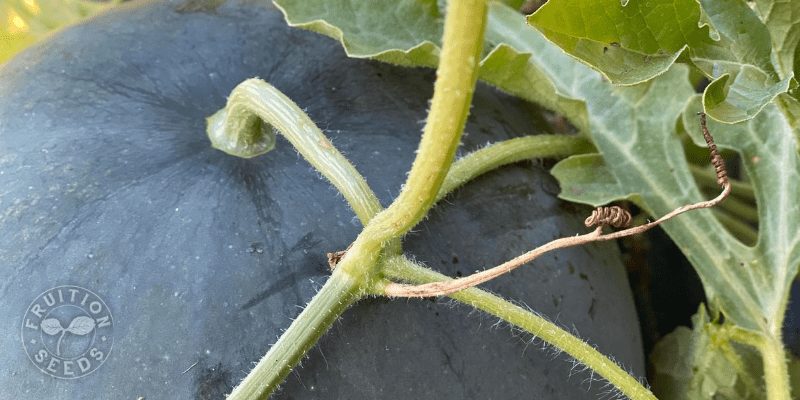
c) The Blanched Underbelly
As both watermelon and cantaloupes ripen, the rind immediately touching the ground often blanches a bit. The least effective of all methods, this simply gives you a general sense that ripening is happening! Your melon may be two weeks away from ripening — and depending on the variety, the blanching may be more or less notable, even when fully ripe.
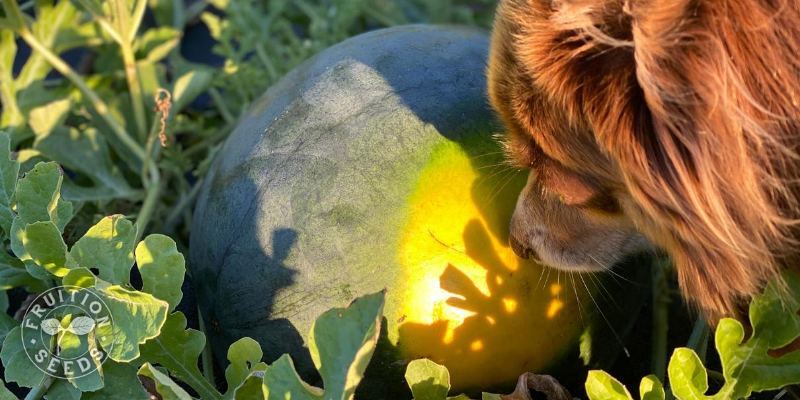
How to know when ripe: Cantaloupe
Without question, cantaloupes are often trickier to tell when ripe compared to watermelons, even for professional growers. There are a few clues, though:
a) Does it Slip?
Many varieties, especially heirlooms, simply ‘slip’ off the vine when ripe: The fruit is so ripe that the stem simply detaches from the fruit at the slightest invitation, sometimes before you even arrive. If only this happened at peak flavor 100% of the time! Alas, it does not. Each of the cantaloupes Fruition offers share this quality though, which is so convenient.
b) Color + Netting
Depending on variety, the ripe fruit will express a distinct color and texture associated with ripeness. Since there are so many varieties, it’s not possible to describe patterns that will work for them all, alas!
Some melons, like our Petit Gris de Renne , are sincerely challenging since it’s rind is smooth both unripe and ripe, as well as the color shift being subtly more yellow green (‘gris’ = gray in French) at peak. She is the crème de la crème of the Charantais-style melons though, with flavor you’ll never find elsewhere. The scent is your best clue for these beauties
Delicious 51 (above!) makes it easier, her rind becoming netted with a gorgeous lattice as she ripens. In addition to softening slightly, the color underneath that lattice will shift from deep to light green to orange as she ripens, as well. Anywhere from light green (above) to orange is heaven.
Sharlyn has the widest window of ripeness of any melon we’ve found, with glorious honeydew-style flesh (bottom slice) maturing to tropical, melt-in-your-mouth sweetness 7 to 10 days later (top slice).
Sharlyn is by far the easiest, for many reasons. First, she is absolutely delicious about seven to ten days before she is fully ripe, offering you the widest harvest window of any melon we’ve found. Fully immature fruits have smooth, deep green rinds; they’re maturing as their skin begins to net, first with long, embossed ‘crackles,’ though they’re still not tasty at that stage. Once those crackles extend and connect, forming the lattice around the green rind, now your Sharlyn has reached her first peak of deliciousness! Though her stem doesn’t ‘slip,’ her flavor is rich, bright honeydew at that stage, her flesh firm and green with a seed cavity just blushing the color of cantaloupe. Seven to ten days later, the rind under her lattice is deep yellow-orange and the fruits slip off the vine by themselves. At that stage, the melt-in-your-mouth flesh has turned white with tropical fruit sweetness, utterly luscious. Every flavor between these stages is heaven.
c) Heaven Scent
Unlike watermelon, many cantaloupe are fragrant by the stem as well as blossom end when ripe. The nose knows.
Bon Chance & Bon Appetit!
Friends, it is never simple to know when a melon is ripe. But with a little experience and a lot of attention, it is a joy to grow these sumptuous fruits and the challenge makes them that much sweeter!
Sow Seeds & Sing Songs,

and the Many Beings of Fruition

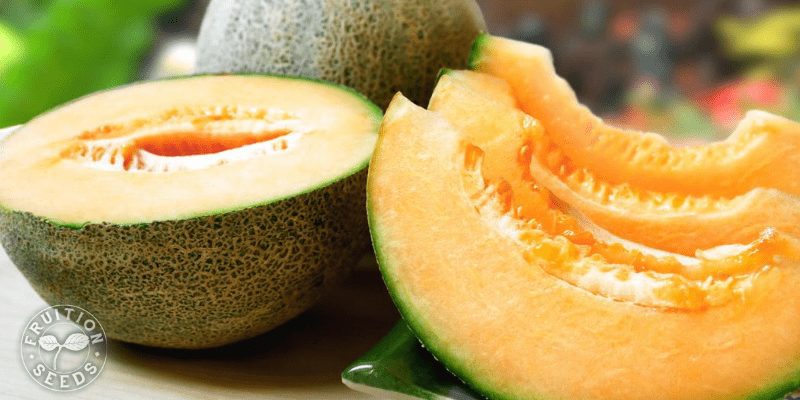
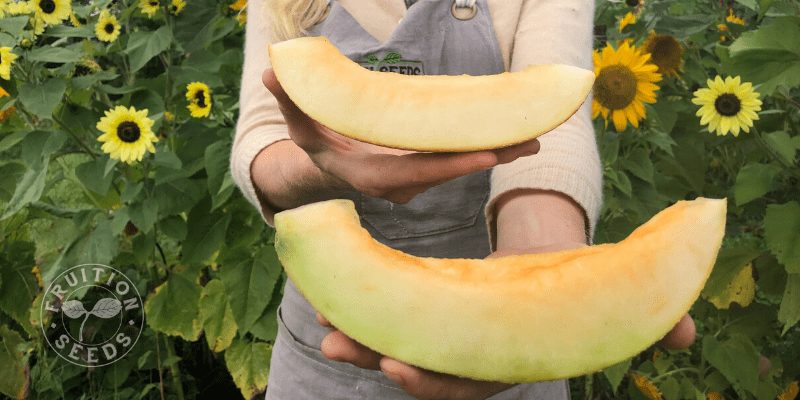
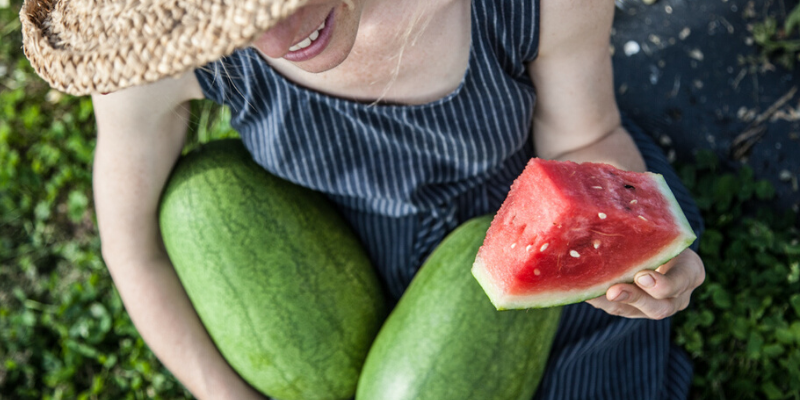
Thank you so much. How did you know I picked my first melon yesterday. I think I could have waited a couple more days but I went by the wonderful scent.
thank you!!!!
delightful percussion performance!
ha!
so much to learn…
I picked one of my watermelons too early this year and I was bummed. But there is another one growing so I’ll be sure to try some of these techniques! Thank you !!
Love your delightful, educational and fun videos…Always something to learn!
I love your description!! Makes me want to go eat one!! I am planning on growing a batch of melons, I’m in central maine and have beautiful Sandy loam soil. I will be starting them in low tunnels. What would you recommend?
I need some help with my butternut squash plants. It has been very hot but I do try to keep them watered. Today I noticed that the leaves all have little white spots on them. It looks like powdery polkadots. Would it be caused by lack of water or some kind of fungus? Thanks for your help.
Sounds like powdery mildew. I’ve got some on a few of my pumpkin plants. It apparently spreads faster in hot, dry weather.
Fabulous lesson! Thank you!